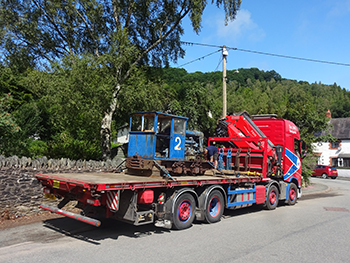| THE BRITISH OVERSEAS RAILWAYS HISTORICAL TRUST
A UK Registered Educational Charity |  |
OUR LOCOMOTIVE
 |  |
| Loading the locomotive at Glyn Ceiriog, Wales [Photo: Eddie Lambert] | The locomotive at Bredgar [Photo: Julian Rainbow] |
NEWS
In 2018 we were given a small 60 cm gauge oil engined locomotive by our late Vice-President Dr Paul Waters. We do not know its builder or much of its history and so we would be interested to hear from anybody who recognises it. It is powered by a Fordson tractor which must weigh more than half the total weight of the locomotive and so we are happy to accept it as a British built locomotive.
There are a few things missing - most importantly the dynamo, driver's seat and exhaust silencer.
We have been given a repair manual for the Fordson Major fitted with a Perkins P6 Tractor engine, which was required before work can start on its restoration as it has some unusual features such as an injection pump with a pneumatic governor, which is controlled by vacuum created by a butterfly in the inlet manifold.
We also need a team to work on it in the Sittingbourne area.
HISTORY
| The locomotive at Maldegem | The locomotive when it arrived at Glyn Valley |
As one can see from the photographs, the locomotive is powered by a Fordson Major tractor. It has a Perkins P6 tractor engine, which Ford offered as an alternative to their own petrol engine from 1948 to 1952. That the suspension has helper coil springs fitted suggests that it has been uprated at some time with the Fordson Major. We have seen a photograph taken in the 1930's of a Fordson powered locomotive with an almost identical underframe, working on a beach tramway at St. Anna, Antwerp.
Its recent history is that it worked at a brick works called Sternberg at Aalbeke, just to the south of Kortrijk, Belgium, together with two sisters. When the railway finished there, it was bought by Mr. Noel Schieur who had it at his home in Beselare. It was bought by the Maldegem Stoomcentrum with two WW2 Simplex locomotives in 2014 and advertised for sale in Old Glory for May 2014. The contact telephone number told the BORHT team who was selling it. We had a stand at the Maldegem Festival that year as usual and inspected the locomotive. However, it had been sold. A few months later we were contacted by the Stoomcentrum to say that the sale had fallen through and would we buy it as the only other offer that they had had was from somebody who wanted to rebuild it as a tractor. So, it was sold on to P E Waters & Associates. In 2018 it was bought by the Trust using a donation specific for that purpose and it was moved to North Wales in April 2018 where it stayed at the Glyn Valley Railway, Glyn Ceiriog until it was moved to the Bredgar and Wormshill Light Railway, The Warren, Swanton Street, Bredgar, Kent ME9 8AT in late June 2025.
Subsequent to its move to Bredgar BORTH was contacted by Allan Condie, a noted Fordson expert who has provided manuals and technical information. His initial thoughts were "it looks as if it has been built new with the Perkins P6 engine due to the presence of a single filler tank (unless of course it was all petrol from new. The P6 engine and Fordson gearbox are linked up to a reverse direction final drive unit from which the wheels are driven by roller chain.
- Built as new using a Fordson skid unit but a spark ignition engine (either for operation on straight petrol or Tractor Vaporising Oil
* ) which was later converted to P6 diesel - Built as new with the P6.
- Built with a different power unit and gearbox and converted using a second-hand tractor with the rear transmission removed. I've seen this done with other applications.
It does not fit the imprint of UK built examples Muir Hill or Hudson."
Allan told us where to find the tractor serial number etc and we visited Bredgar to see what we could find out. We then sent Allan many photographs and Allan told us that his interim conclusions were that: "If there is no tractor number on the flange, I suspect that the unit was built with a spark ignition engine and possibly converted later. The underframe doesn't resemble any UK built Fordson based locos that I have come across – so does one assume it was built in Belgium. Fordson Majors were sold in Belgium."
:
|
A STORY OF BRITISH EXPORT ACHIEVEMENT |
| Registered Charity No 290944 | Company Limited by Guarantee No 1862659 |